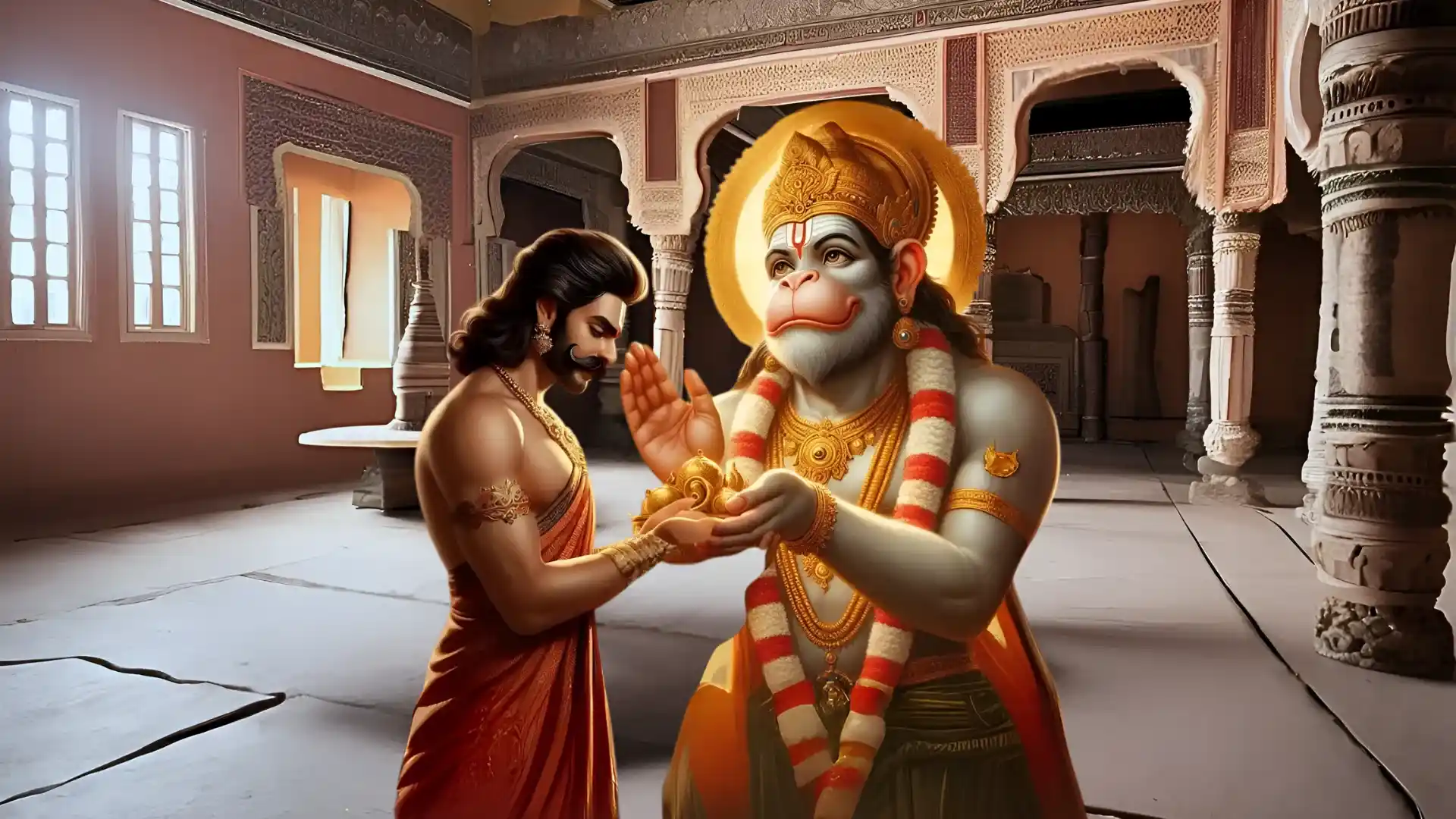Vadvanal Stotram: 6 Powerful Aspects
- Removes obstacles and hindrances: Symbolized by the word “Vadvanal” (forest fire).
- Cleanses karmic burdens: Reduces negative planetary effects.
- Grants physical and mental strength: Enhances endurance for sadhana.
- Eliminates negative energies: Protects against Jinn, Bhoot, Pret, and more.
- Accelerates spiritual growth: Deepens devotion and uplifts spiritually.
- Enforces discipline and rituals: Requires strict adherence to spiritual guidelines.
Understanding the Classification of Sanatan Dharmic Deities
There are 3 types of Sanatan Dharmic deities. The Satvic deities, the Rajasic deities, and the Tamasic deities. Lord Vishnu is the Lord of Satvik Worship, Devi is the Goddess of Rajic worship, and Lord Shiva is the deity of tamasic worship. Sri Hanuman has both satvik and tamasic forms. That is because, being the 11th Rudra Avtar of Lord Shiva, he was an ardent devotee of Lord Rama. We shall discuss the details of the Hanuman Vadvanal Stotra in this post.
Sri Vibhishana: The Composer of the Hanuman Vadvanal Stotram
The word Vadvanal itself means forest fire, which can represent the obstacles and problems the Sadhaka faces. Recitation of this Stotra hence removes all hindrances in the spiritual journey of the Sadhaka. Vibhishanji, the brother of the demon Ravana, composed this hymn.

Demon by birth, King Vibheshana was an ardent devotee of Lord Rama and Hanumanji Maharaj. He was Ravana’s only subordinate who opposed the Sita Haran and advised his brother to return Mata Sita to Sri Ramachandra.
First, we should delve deep into understanding the greatness of this stotram and its composer Sri Vibhishana. Many consider King Vibheshana a traitor who joined the opposing army. This is never true. It is not True because people view Vibheeshana with a materialistic viewpoint, discounting the highest spiritual angle, which is the way to look at things.

A truly Spiritual Person considers Bhagavan as His only friend, Parent and Benefactor where blood relations are of little value, if they are opposed to Sri Bhagavan.
Vibheeshana’s heart was full of Sri Rama alone. Although he was bound to his Adharmic brother Ravana, ultimately he was successful in breaking ties with the Lord’s enemy, Ravana, the stealer of the Lord’s eternal consort.
How can such a great soul such as Vibheeshana be considered a traitor. A person who considers Vibheeshana as such, has probably not grasped the import of the Highest Spiritual teachings of Sanatana Dharma. It is important to understand the deeper significance of our Pauranic stories.
The Lord of Lanka, Ravana, was a renowned Pandit well versed in scriptures, yet he performed evil acts. One should not idolize such a character, which many of us do, owing to our deep-rooted ignorance about Dharma.

Knowing the scriptures and understanding them does not have any value until one implements it in his daily life. The one who always stood true to his morals and fearlessly advised his brother to tread the path of Dharma was King Vibhishana.
He abandoned Lanka after being ridiculed by his brother Ravana and surrendered himself to Sri Rama. This is the sign of a true devotee. One who studies the Ramayana can see a close connection between Lord Hanuman and King Vibheshan.
The Unique Connection Between Vibhishana and Lord Hanuman
Lord Hanuman was the only one to praise the virtues of Vibhishan when the Vanara generals of Sri Rama’s army opposed the joining of Vibhishana to the Lord’s . Hence, the stotram is a tribute to the great Rama devotee Hanuman, by another Rama devotee, Vibhishana. Here, a devotee sings the praise of another devotee increasing the potency of the hymn.
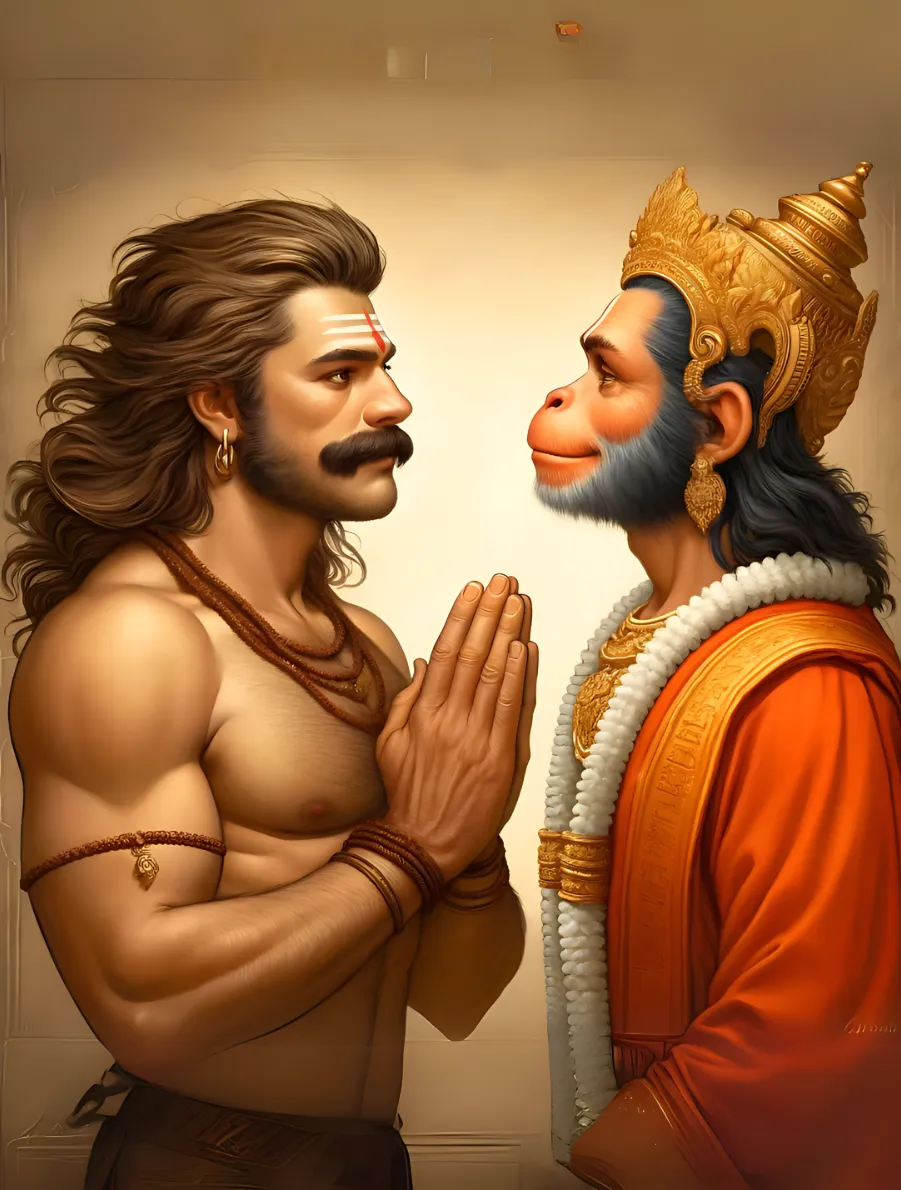
It is said that when Lord Hanuman flew across the ocean to Lanka, he was first attracted to Vibhishana’s residence. Vibhishana was a devotee from the start; however, his devotion was yet to blossom.
His first encounter with Lord Hanuman in Lanka served as a catalyst in speeding up his Bhakti. Vibhishana was a Pandit just like his brother and had knowledge about Tantra. Hence, he has worshiped Sri Hanuman in the Tantric Way.
The form of Lord Hanuman however is not Saumya or gentle, unlike the typical manifestation where he is in Dasya or the mood of service. In this manifestation, Hanuman ji is a Devata or a living deity having a distinct character. Lord Hanuman is in a fighter spirit, very quick to respond to the call of his devotees. He approaches the sadhaka with the intensity of fire.
The hymn also represents the great burning of Lanka, the apparently golden kingdom of lust, greed and attachment by the fierce form of Hanumanji Maharaj.

The Vadvanal Stotram falls under the Tamasica hymns related to Lord Hanuman and has various Beejas. One has to follow many rules while reciting the Beeja mantras.
One should never chant Beejas without taking proper initiation. Sadhakas who have taken Guru Diksha are only qualified to chant Stotras and mantras. The bodily functions of children and women are not suitable for chanting such Stotrams.
What is the Vadvanala Stotram Equivalent Yantra (Panchamukhi Hanuman Yantra)
The Panchamukhi Hanuman Yantra is the geometric and energetic counterpart to the powerful Vadvanala Stotram. In the world of Tantra and Mantra sadhana, each potent stotra has a Yantra associated with it. For the fierce and protective Hanuman Vadvanala Stotram, that Yantra is none other than the Panchamukhi Hanuman Yantra.
This sacred Yantra is aligned with the energy of the five-faced (Panchamukhi) form of Lord Hanumanji Maharaj, a form that was assumed by the great vanara warrior to defeat the demon Mahiravana in Patala Loka. Just like the stotram burns away negativity like a forest fire, this Yantra radiates protective and purifying vibrations when properly installed and worshipped. It carries within it the shakti of Hanumanji’s five aspects, each face representing a unique energy force, direction, and purpose. Together, they act as a shield against black magic, planetary doshas, evil spirits, and mental agitation.
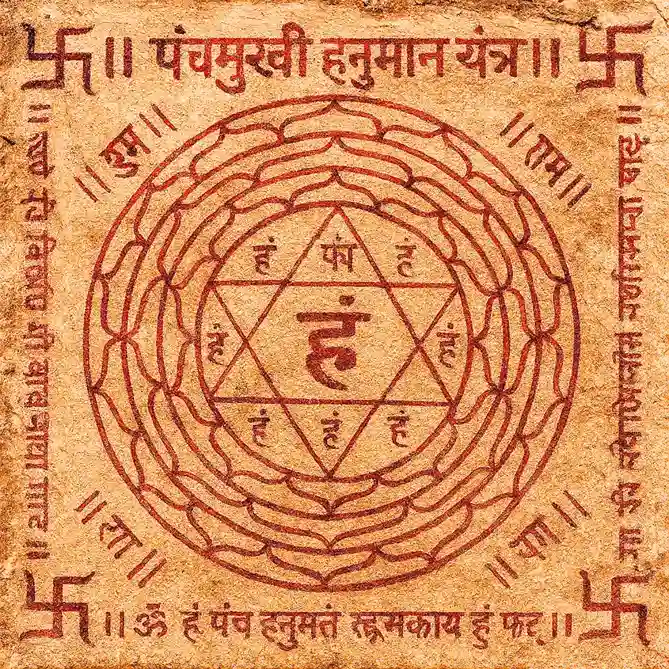
This Yantra is etched traditionally on Bhojapatra or copper, and acts as a spiritual fire—Vadavanala—that digests all karma when energized and invoked under Guru guidance.
Benefits of the Panchamukhi Hanuman Yantra
The Panchamukhi Hanuman Yantra is not a mere decorative piece; it is a living spiritual technology. When sanctified through mantra chanting and Guru Deeksha, it becomes a divine transmitter of Lord Hanuman’s shakti. Its benefits unfold slowly but deeply, transforming the devotee’s life from within:
This Yantra brings immense protection to the home and heart. It safeguards the Sadhaka from evil spirits, dark energies, and planetary maleficence (Graha Dosha). Many have experienced relief from nightmares and mental disturbances simply by keeping this Yantra near their pillow.
It empowers the user with tremendous willpower and inner stability, especially during difficult phases of life. The inner restlessness that once dominated the mind begins to fade, replaced by deep faith and calm. Those suffering from frequent obstacles in career, family disputes, or legal conflicts experience new breakthroughs. The Yantra dissolves invisible karmic knots that create tension and delay.
The Panchamukhi form enhances the energy of the Manipura Chakra (solar plexus), strengthening one’s personal resolve, leadership qualities, and confidence. This Yantra builds a natural discipline in the devotee—one becomes punctual in sadhana, regular in prayers, and begins to seek higher knowledge naturally.

It uplifts the heart with bhakti. The fierce form of Hanuman may seem terrifying, but to the devotee, it becomes tender, like a father’s strict love.
In many cases, people who could not progress in mantra chanting found themselves drawn deeply into practice after receiving this Yantra.
Psychic attack protection is one of the Yantra’s most underrated benefits. The five faces represent five divine shields, repelling subtle attacks from unseen realms. Women in particular, when advised by a Guru, find relief from unexplained emotional and energetic imbalances by keeping this Yantra in their puja space.
Above all, the Yantra increases one’s connection to Hanumanji, guiding the devotee into Ram Bhakti and dissolving all forms of fear and confusion.
The Structure of the Panchamukhi Hanuman Yantra
The Panchamukhi Hanuman Yantra is a sacred geometrical design composed of intersecting triangles, circles, lotus petals, and bija mantras—each etched with precision and purpose. In its central bindu resides the core energy of Panchamukhi Hanuman, flanked on all sides by protective patterns.
Each of the five faces of Lord Hanuman governs one direction and a unique spiritual quality:
- East: Hanuman (original face) – removes obstacles and grants strength
- South: Narasimha – eliminates fear and destroys demons
- West: Garuda – shields from black magic and poison
- North: Varaha – stabilizes the mind and ensures victory
- Skyward (Urdhva): Hayagriva – bestows knowledge and clarity
These faces are invoked through their respective seed syllables (bija mantras) placed in the Yantra.

The lotus petals around the bindu represent purity of intention. The triangle pointing upwards symbolizes fire (Agni), willpower, and inner transformation. Squares enclosing the outer structure depict stability, protection, and groundedness.
When drawn correctly, especially on Bhojapatra with natural ink and energized in the presence of a Siddha Guru, it becomes a channel of divine intervention. You may read our article on AshtaLakshmi Yantra to explore the eightfold blessings of wealth, harmony, and abundance.
Geometrical Significance and Energy Patterns of the Panchamukhi Hanuman Yantra
The Yantra’s geometry is not symbolic—it is energetic. Every curve and corner holds vibrational resonance. When the sadhaka gazes at the Yantra, subtle currents begin to flow through their subtle body (sukshma sharira). The upward triangle symbolizes Tejas (inner fire), awakening courage, transformation, and inner digestion of fear. The concentric circles denote cycles of karma that are now brought into conscious awareness and resolved.
The presence of the five directions through the five faces creates a multidimensional protection grid around the user. Just as Hanuman circled Lanka during his search for Sita, the Yantra’s design circles the devotee with energetic vigilance. The alignment of syllables in this Yantra creates a spiritual resonance when mantras are chanted in its presence. These bijas act as keys unlocking different aspects of the inner self.
Each lotus petal is not merely design but an energetic node. The breath, when controlled during chanting, naturally aligns with these nodes, guiding prana through the chakras. More importantly, the Yantra creates a state of dharana, one-pointed concentration. The eyes may begin the process, but the heart completes it.
When energized and placed on a clean altar, this Yantra not only protects but also acts as a karmic filter, digesting past-life residues. This is the unseen but life-changing impact of the Panchamukhi Yantra.
Mantras for the Panchamukhi Hanuman Yantra: The Role of Guru and Deeksha
The power of the Panchamukhi Yantra multiplies exponentially when used with the correct mantras. But these are not mantras to be picked from a book or internet—they require initiation (Guru Deeksha).
The most powerful mantras used to activate this Yantra include:
- Om Namo Bhagavate Panchavaktraya Aanjaneyaaya Mahabalaaya Swaha
- Panchamukhi Hanuman Gayatri:
“Om Urdhva Mukhaaya Vidhmahe, Panchavaktraaya Dheemahi, Tanno Hanumat Prachodayat”
In some cases, the Vadvanal Stotram itself is used as the medium of activation. But again, this is done only under the watchful guidance of a Guru.
Mantras are like electrical currents. If one doesn’t know the correct voltage, they can burn the system. The Guru not only gives the right mantra, but also prepares your system to hold its shakti.
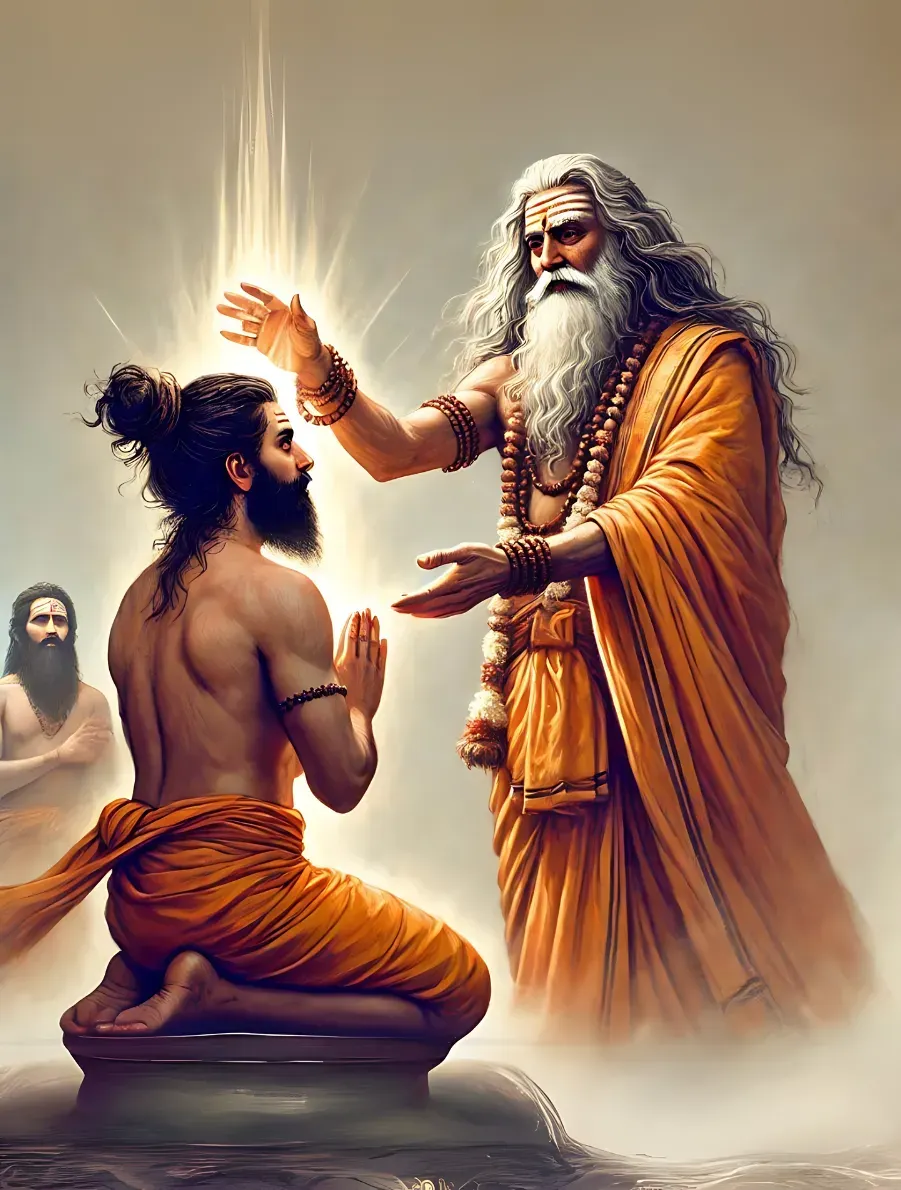
He adjusts the mantra for your karma, your voice, your pranic strength. That’s why the same mantra works for one but not for another—it depends on the Guru.
Maintaining the mantra’s activation is equally important. Mantras fade if not used. The Guru teaches how to breathe with the mantra, how to place your attention on the Yantra’s core while chanting. This is the secret science of mantra-yantra saadhana.
How the Panchamukhi Hanuman Yantra is Made at yantrachants.com
At yantrachants.com, the Panchamukhi Hanuman Yantra is not mass-produced; it is lovingly and authentically created using traditional methods. We use purified Bhojapatra sheets, hand-processed in a sanctified space. The ink is made using natural herbs, lamp black, and Ganges water to preserve scriptural purity.
Each Yantra is inscribed manually with a pomegranate twig, following the exact dimensions laid out in ancient scriptures. The sacred geometry is maintained with utmost precision. The bija mantras are written during a specific Muhurat (astrological timing) to ensure potency.
But what truly sets our Yantras apart is the Guru Parampara. Each Yantra is energized by our Parampara Acharya, Guruji Shri Damodar Das Maharaj. It is placed in front of the Parampara Panchamukhi Hanumanji Deity and is invoked using Vedic mantras, with proper rituals. Mantras are chanted for hours until the Yantra vibrates with power. Only then is it sent to the devotee, along with basic instructions on how to install and worship it.
We do not sell art; we distribute divine force. Every Yantra from yantrachants.com is a living presence. That’s our promise.
Importance of a Self-Realized Master in Energizing the Yantra
Only a Self-Realized Master, a Sadguru who has gone beyond the mind, can truly awaken the shakti in a Yantra. Such beings have already merged with the deity, so when they energize the Yantra, they transfer their inner fire into the geometric form.
For an ordinary person, the Yantra may look like lines and mantras. But when a Self-Realized Master touches it with mantra, it comes alive. It becomes a spiritual transmitter. Such a Yantra doesn’t need repeated rituals. It works in auto-mode. Just by keeping it in your space, your subtle body begins to adjust. Negative energies withdraw. Dreams change. Thoughts purify.
Even your surroundings shift, family members become calm, pets rest peacefully, arguments dissolve. The Yantra begins working without you even realizing.
This is the Grace of a Self-Realized Guru. He doesn’t just give a mantra or yantra. He gives himself—his awakened presence.
Rare Insights into the Usage of Panchamukhi Hanuman Yantra and Mantra Practice
The Panchamukhi Hanuman Yantra has been used by warriors, tantrikas, and householders for centuries. But its secrets are often lost. Here are some rare insights:
- Chanting the Vadvanal Stotram facing south with this Yantra placed on a red cloth brings immediate removal of fear.
- Women undergoing sudden spiritual awakenings find balance when they meditate upon this Yantra under a Guru’s care.
- When kept near an ill person’s bed, it acts as a pranic stabilizer, especially for mental health and fevers.
- Chanting Hanuman Beeja Mantra while gazing at the bindu sharpens focus and reduces tamas (inertia).
- Business people facing delays can place the Yantra at their entrance, lighting a mustard oil lamp beside it every Tuesday.
- The Yantra also works beautifully when combined with Hanuman Chalisa chanting, set it up during Brahma Muhurta (before sunrise) and witness the shift.
With a Guru’s guidance, these practices amplify your inner transformation.
The Tantric Significance of the Panchamukhi Hanuman Form
The Panchamukhi form is no ordinary depiction, it is a Tantric revelation. According to Agama scriptures, when Hanumanji Maharaj descended into Patala to rescue Lord Rama and Lakshmana from Mahiravana, he took the five-faced form to defeat five magical lamps burning in five directions. Each face had a mission. Lord Narasimha destroyed Mahiravana’s tamasic hold. Lord Garuda neutralized the poison spells. Bhagawan Varaha protected dharma. Bhagawan Hayagriva restored divine memory.
In Tantra, this form represents the awakened Kundalini overcoming all obstacles. The Yantra thus acts like a chakra-aligning machine. In some Tantric schools, the Panchamukhi Hanuman Yantra is used in advanced rituals for removing ancestral curses and karmic blocks from past lives.
This is no casual symbolism, it is a spiritual science tested through centuries of sadhana.
Combined Power of Vadvanala Stotram and Panchamukhi Hanuman Yantra
When the Vadvanala Stotram is chanted with deep surrender and the Panchamukhi Hanuman Yantra is placed before the Sadhaka, the results are dramatic. The mantra activates, the Yantra amplifies. The fear that haunted for years suddenly lifts. Karmic entanglements begin to break.
With proper guidance, this pair becomes the ultimate armor, protecting the body, mind, and soul. It is not just a sadhana; it is a yajna of one’s entire being.
Powerful Benefits of the Vadvanal Stotram
I recommend women and children should not recite this mantra until advised by a trained guru. The Hanuman Vadvanal Stotra starts by praising Lord Hanuman with the very famous Dhyanam hymn-
मनोजवं मारुत-तुल्य-वेगं जितेन्द्रियं बुद्धिमतां वरिष्ठं ।
वातात्मजं वानर-यूथ-मुख्यं श्रीरामदूतम् शरणं प्रपद्ये ।।
manojavaṃ māruta-tulya-vegaṃ jitendriyaṃ buddhimatāṃ variṣṭhaṃ |
vātātmajaṃ vānara-yūtha-mukhyaṃ śrīrāmadūtam śaraṇaṃ prapadye ||
The Stotram then transforms into a prayer asking Hanumanji to remove all diseases, bad omens, and fears. Well, the Stotram also holds a great astrological significance. It reduces all the ill-effects of unfavorable planets and the burden of karmic load.
To help seekers understand its depth, we have publiched the Hanuman Vadvanal Stotra meaning in English, revealing not just the translation but the emotional and energetic layers behind each verse.
ध्यान (Dhyāna: Meditation Verse)
Transliteration:
manojavaṁ māruta-tulya-vegaṁ jitendriyaṁ buddhimatāṁ variṣṭham
vātātmajaṁ vānara-yūtha-mukhyaṁ śrīrāmadūtaṁ śaraṇaṁ prapadye
Translation:
I take refuge in Śrī Rāma’s messenger, Hanuman—
Swift as the mind, fast as the wind,
Conqueror of the senses, supreme among the wise,
Son of the Wind God, chief of the monkey army.
Main Stotra Begins
1.
ॐ ह्रां ह्रीं ॐ नमो भगवते श्रीमहा-हनुमते प्रकट-पराक्रम
oṁ hrāṁ hrīṁ oṁ namo bhagavate śrīmahā-hanumate prakaṭa-parākrama
Salutations to Lord Mahā Hanumān, whose valour is openly manifest.
2.
सकल-दिङ्मण्डल-यशोवितान-धवलीकृत-जगत-त्रितय
sakala-diṅmaṇḍala-yaśo-vitāna-dhavalīkṛta-jagat-tritaya
Whose fame pervades all directions and illuminates the three worlds.
3.
वज्र-देह रुद्रावतार लंकापुरीदहय उमा-अर्गल-मंत्र
vajra-deha rudrāvatāra laṅkāpurīdahaya umā-argala-mantra
With a body hard like thunderbolt, Rudra’s incarnation, burner of Lanka, wielder of Umā’s protective mantra.
4.
उदधि-बंधन दशशिरः कृतान्तक सीताश्वसन वायु-पुत्र
udadhi-bandhana daśaśiraḥ-kṛtāntaka sītāśvasana vāyu-putra
Who bridged the ocean, destroyed ten-headed Rāvaṇa, comforted Sītā, and is the son of the Wind God.
5.
अञ्जनी-गर्भ-सम्भूत श्रीराम-लक्ष्मणानन्दकर कपि-सैन्य-प्राकार
añjanī-garbha-sambhūta śrīrāma-lakṣmaṇānandakara kapi-sainya-prākāra
Born of Añjanī, giver of joy to Śrī Rāma and Lakṣmaṇa, fortress of the monkey army.
6.
सुग्रीव-साह्यकरण पर्वतोत्पाटन कुमार-ब्रह्मचारिन् गंभीरनाद
sugrīva-sāhyakaraṇa parvatotpāṭana kumāra-brahmacārin gambhīranāda
Helper of Sugrīva, lifter of mountains, celibate warrior, whose voice is deep like thunder.
7.
सर्व-पाप-ग्रह-वारण-सर्व-ज्वरोच्चाटन डाकिनी-शाकिनी-विध्वंसन
sarva-pāpa-graha-vāraṇa sarva-jvaroccāṭana ḍākinī-śākinī-vidhvaṁsana
Remover of sins, dispeller of fevers, destroyer of malevolent spirits like Dākinīs and Śākinīs.
Healing and Protective Invocation
8.
ॐ ह्रां ह्रीं ॐ नमो भगवते महावीर-वीराय सर्व-दुःख निवारणाय
oṁ hrāṁ hrīṁ oṁ namo bhagavate mahāvīra-vīrāya sarva-duḥkha nivāraṇāya
Salutations to the heroic Mahāvīra Hanumān, remover of all sorrows.
9.
ग्रह-मण्डल सर्व-भूत-मण्डल सर्व-पिशाच-मण्डलोच्चाटन
graha-maṇḍala sarva-bhūta-maṇḍala sarva-piśāca-maṇḍaloccāṭana
You dispel evil influences of planets, spirits, and ghosts.
10.
भूत-ज्वर-एकाहिक-ज्वर, द्वयाहिक-ज्वर, त्र्याहिक-ज्वर
bhūta-jvara-ekāhika-jvara, dvayāhika-jvara, tryāhika-jvara
You cure fevers caused by spirits—fevers of one, two, and three days’ duration.
11.
चातुर्थिक-ज्वर, संताप-ज्वर, विषम-ज्वर, ताप-ज्वर,
cāturthika-jvara, santāpa-jvara, viṣama-jvara, tāpa-jvara,
Curing chronic, burning, irregular, and heat fevers alike.
12.
माहेश्वर-वैष्णव-ज्वरान् छिन्दि-छिन्दि यक्ष ब्रह्म-राक्षस
māheśvara-vaiṣṇava-jvarān chindi-chindi yakṣa brahma-rākṣasa
Destroying divine fevers, and beings like Yakṣas and Brahma-Rākṣasas.
13.
भूत-प्रेत-पिशाचान् उच्चाटय-उच्चाटय स्वाहा।
bhūta-preta-piśācān uccāṭaya-uccāṭaya svāhā
Exorcise ghosts, spirits, and ghouls—svāhā!
Sound Form & Mantra Shakti
14.
ॐ ह्रां ह्रीं ॐ नमो भगवते श्रीमहा-हनुमते
oṁ hrāṁ hrīṁ oṁ namo bhagavate śrīmahā-hanumate
Salutations to Mahā Hanumān, with seed syllables Hrāṁ and Hrīṁ.
15.
ॐ ह्रां ह्रीं ह्रूं ह्रैं ह्रौं ह्रः आं हां हां हां हां
oṁ hrāṁ hrīṁ hrūṁ hraiṁ hrauṁ hraḥ āṁ hāṁ hāṁ hāṁ hāṁ
Powerful sonic vibrations of Hanumān’s essence.
16.
ॐ सौं एहि एहि ॐ हं ॐ हं ॐ हं ॐ हं
oṁ sauṁ ehi ehi oṁ haṁ oṁ haṁ oṁ haṁ oṁ haṁ
Come, come! Oṁ Haṁ,invoking presence and energy repeatedly.
Exorcism & Maya-Bhedana
17.
ॐ नमो भगवते श्रीमहा-हनुमते श्रवण-चक्षुर्भूतानां
oṁ namo bhagavate śrīmahā-hanumate śravaṇa-cakṣurbhūtānāṁ
O Mahā Hanumān, granter of divine hearing and sight to beings.
18.
शाकिनी डाकिनीनां विषम-दुष्टानां सर्व-विषं हर हर
śākinī ḍākinīnām viṣama-duṣṭānāṁ sarva-viṣaṁ hara hara
Destroy poisons of evil beings, sorceresses, and witches.
19.
आकाश-भुवनं भेदय भेदय छेदय छेदय मारय मारय
ākāśa-bhuvanaṁ bhedaya bhedaya chedaya chedaya māraya māraya
Pierce the heavens, cut through, strike and destroy!
20.
शोषय शोषय मोहय मोहय ज्वालय ज्वालय
śoṣaya śoṣaya mohaya mohaya jvālaya jvālaya
Dry them up, delude them, burn them!
21.
प्रहारय प्रहारय शकल-मायां भेदय भेदय स्वाहा।
prahāraya prahāraya śakala-māyāṁ bhedaya bhedaya svāhā
Attack and shatter all illusions—svāhā!
Graha Shanti & Bandhana Moksha
22.
ॐ ह्रां ह्रीं ॐ नमो भगवते महा-हनुमते सर्व-ग्रहोच्चाटन
oṁ hrāṁ hrīṁ oṁ namo bhagavate mahā-hanumate sarva-grahouccāṭana
O great Hanumān! Remove all malefic planetary influences.
23.
परबलं क्षोभय क्षोभय सकल-बंधन मोक्षणं कुर-कुरु
parabalaṁ kṣobhaya kṣobhaya sakala-bandhana mokṣaṇaṁ kura-kuru
Agitate enemy forces; break all bonds and grant freedom.
24.
शिरः-शूल गुल्म-शूल सर्व-शूलान्निर्मूलय निर्मूलय
śiraḥ-śūla gulma-śūla sarva-śūlānnirmūlaya nirmūlaya
Eradicate all afflictions—headaches, abdominal pain, and all types of bodily torment.
25.
नागपाशानन्त-वासुकि-तक्षक-कर्कोटकालियान्
nāgapāśānanta-vāsuki-takṣaka-karkoṭakāliyan
Nullify serpent curses from Ananta, Vāsuki, Takṣaka, Karkoṭa, and Kāliya.
26.
यक्ष-कुल-जगत-रात्रिञ्चर-दिवाचर-सर्पान्निर्विषं कुरु-कुरु स्वाहा।
yakṣa-kula-jagata-rātriñcara-divācara-sarpānnirviṣaṁ kuru-kuru svāhā
Render harmless all serpents and Yakṣas that wander day and night—svāhā!
Final Stanza: Protection & Victory
27.
ॐ ह्रां ह्रीं ॐ नमो भगवते महा-हनुमते
oṁ hrāṁ hrīṁ oṁ namo bhagavate mahā-hanumate
Salutations again to the mighty Mahā Hanumān.
28.
राजभय चोरभय पर-मन्त्र-पर-यन्त्र-पर-तन्त्र
rājabhaya corabhaya para-mantra-para-yantra-para-tantra
Remove fear from kings, thieves, and sorcery, mantras, yantras, or dark rituals.
29.
पर-विद्याश्छेदय छेदय सर्व-शत्रून्नासय
para-vidyāśchedaya chedaya sarva-śatrūnnāśaya
Cut off enemy black magic and destroy all enemies.
30.
नाशय असाध्यं साधय साधय हुं फट् स्वाहा।
nāśaya asādhyaṁ sādhaya sādhaya huṁ phaṭ svāhā
Destroy the incurable and make the impossible possible—Huṁ Phaṭ Svāhā!
Closing
।। इति विभीषणकृतं हनुमद् वडवानल स्तोत्रं ।।
iti vibhīṣaṇakṛtaṁ hanumad vaḍavānala stotraṁ
Thus ends the Hanumad Vadavānala Stotram composed by Vibhīṣaṇa.
The Hanuman Vadvanal Stotra Meaning in English
Sri Hanuman is the deity of strength and will, hence, he grants the Sadhaka with both physical and mental strength.

This Stotram is fierce and can remove Jinn, Bhoot, Pret, and Dakani Yakshani-related problems from one’s life. Chanting this mantra cures illnesses related to the brain and heart and also a variety of fever.
One who recites this mantra with single-minded devotion becomes deeply rooted in spirituality. Hanumanji is Jagat Guru. He hence activates groves of knowledge and higher intuition, Chanting this Stotram uplifts one from this material world and guarantees a place in Saket.
For those searching for hanuman vadvanal stotra with meaning, we recommend experiencing the Yantra along with each shloka. Seeing the Yantra while chanting allows the mind to visualize and retain the energy invoked through the mantra.
One becomes committed to Sadhana and Rama Nama, just as Vibhishana stood true to the holy name in the inimical land of Lanka. Chanting this Stotram on a Hanuman Jayanti day doubles its benefits. The hanuman stotram benefits are magnified when paired with a charged Panchamukhi Hanuman Yantra. It becomes more than a chant—it becomes a force that reshapes destiny. Together, the Yantra and Stotram awaken an inner fire that no negativity can endure.
Now let us discuss the process to recite this Stotram.
The Rituals and Restrictions of the Vadvanal Stotram
Unlike other mantras, it is necessary to take a bath before the recitation of this Stotra. In such Sadhanas the rules and restrictions imposed on the Sadhaka become strict. One should stop consuming Non-vegetarian food, liquor, onion, garlic, and smoking.
Not following these instructions may lead to several problems such as frequent nightmares, hallucinations, family disputes, etc. After a bath sit on a Sadhana asana, keeping a Hanuman photo or idol on a wooden seat before you. Face the east direction if reciting the Stotram in the Morning, and the west direction during the evening.

Place an energized Hanuman Yantra on a plank covered by red cloth, in front of you. While reciting the Stotra keep a mustard-lit lamp beside you. To bring faster results, recite the Stotram 108 times on a coral bead mala.
Precautions while Chanting the Vadvanal Stotram
However, one should keep in mind that this hymn falls under the fierce worship of Lord Hanuman and needs guru diksha. Otherwise, performing this practice can cause fear, horrible dreams and loss of confidence, thus giving reversed effects. One can see the benefits of this mantra just after reciting for 41 days, under a God-realized Guru.
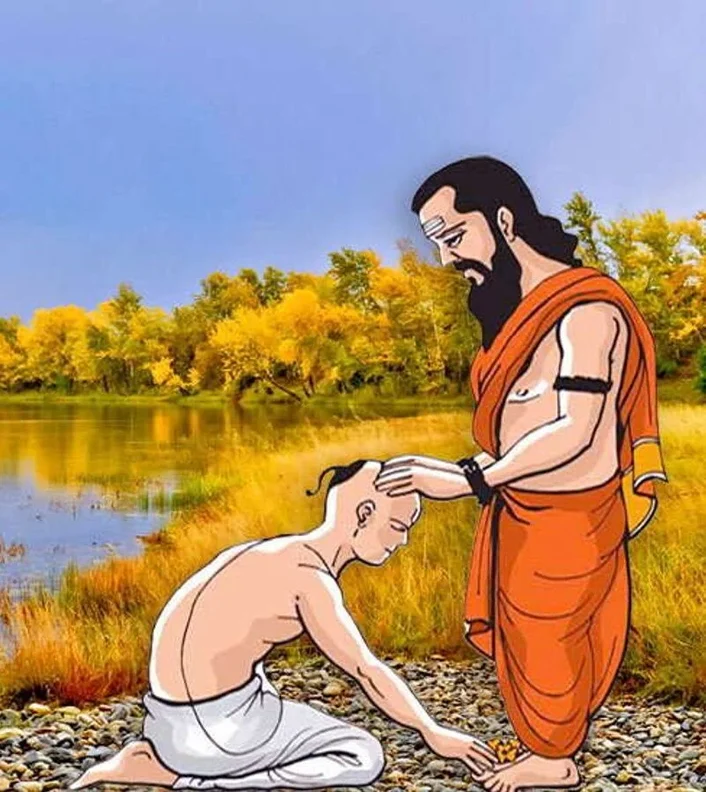
Hanumanji shall certainly grant the wishes of his devotees, if done with expectation, with no discrimination. But remember, if you expect from Hanumanji, even Hanumanji shall not tolerate any mistake in the rules, laid down by the Tantrika Guru.
Just like the Bajrang Baan, one should recite this Stotra only when facing dire situations in life. Hence, in my personal opinion, avoid this Stotram and Sadhana, as much as possible. According to me, chanting Harinaam is the highest and easiest method to attain the highest of all goals, Moksha.
Seek layered protection for your mind, home, and journey. Receive this Panchamukhi Hanuman yantra as prasāda, energized with care.

